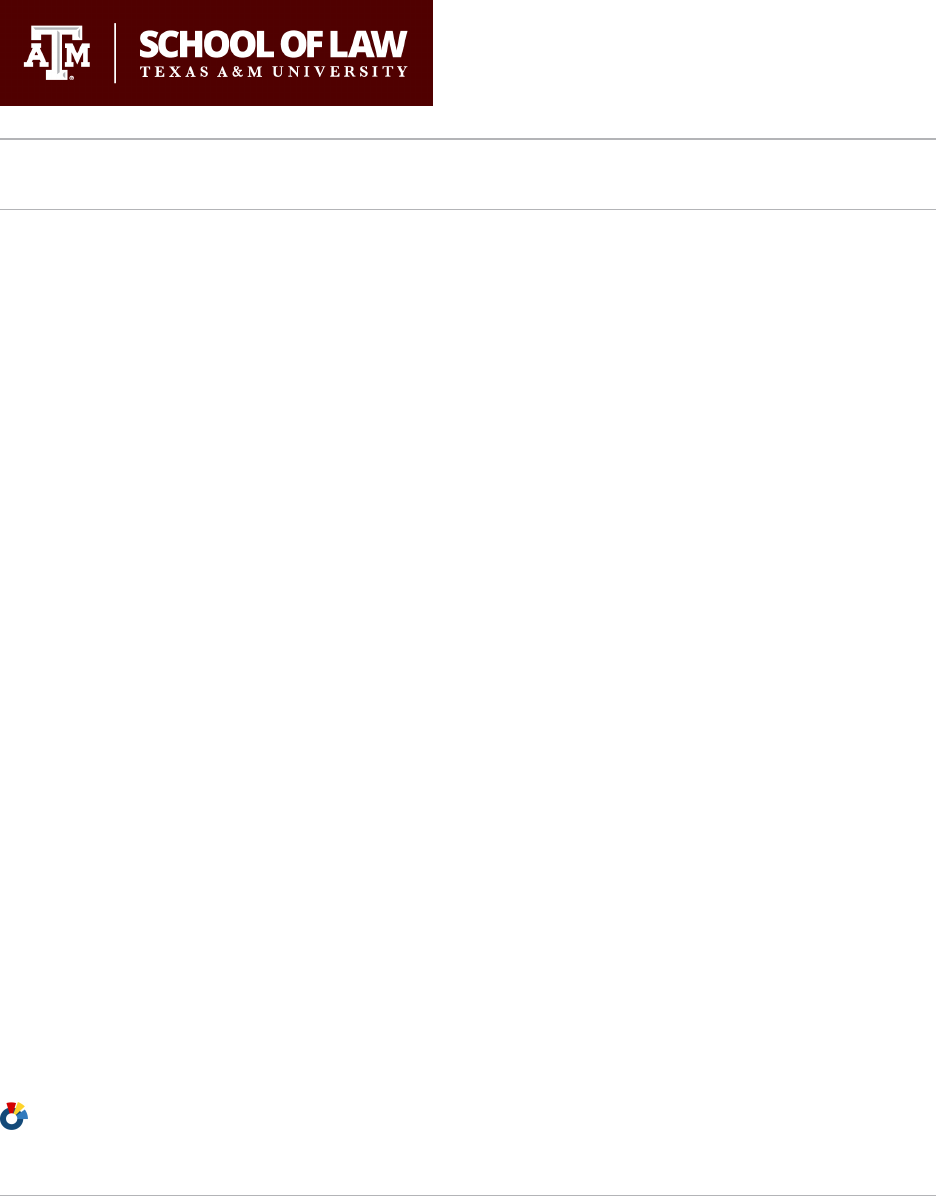
Texas A&M University School of Law Texas A&M University School of Law
Texas A&M Law Scholarship Texas A&M Law Scholarship
Student Scholarship
3-2016
Easement Come, Easment Go - The Cemetery Access Easement: Easement Come, Easment Go - The Cemetery Access Easement:
The Exemption to the Right to Exclude Whose Time Has Come to The Exemption to the Right to Exclude Whose Time Has Come to
Facilitate the Preservation of Nineteenth-Century Texas Family Facilitate the Preservation of Nineteenth-Century Texas Family
Cemeteries Cemeteries
J. Dwight Tom
Follow this and additional works at: https://scholarship.law.tamu.edu/student-scholarship
Part of the Environmental Law Commons, Land Use Law Commons, and the State and Local
Government Law Commons

TOM FINAL(MACROED).DOCXTOM FINAL(MACROED) (DO NOT DELETE) 6/6/2016 1:23 PM
173
Easement Come, Easement Go—The
Cemetery Access Easement: The
Exception to the Right to Exclude Whose
Time Has Come to Facilitate the
Preservation of Nineteenth-Century
Texas Family Cemeteries.
J. Dwight Tom†
I. INTRODUCTION ..................................................................................... 174
II. TEXAS RECOGNITION OF CEMETERIES AND OTHER TEXAS
HISTORICAL SITES ................................................................................ 178
A. Public Memorial and Preservation Efforts ..................................... 178
1. Texas State Historical Markers ................................................ 178
2. Historic Texas Cemetery Program ........................................... 179
3. The Texas Atlas ........................................................................ 179
B. Private Memorial and Preservation Efforts .................................... 179
1. Genealogical Organizations ..................................................... 179
2. The Texas State Historical Association .................................... 180
III. CURRENT TEXAS LAW .......................................................................... 181
A. The Cemetery Access Easement .................................................... 181
1. Exception to the Right to Exclude ........................................... 183
B. Texas Regulatory Scheme ............................................................... 184
1. Dedication of the Land for Cemetery Purpose ........................ 185
2. The Cemetery Access Statute .................................................. 185
3. The Cemetery Access Rule ..................................................... 186
IV. OBSTACLES AND CONCERNS OF ACCESS AND PRESERVATION .............. 187
A. Removal of the Cemetery Dedication ............................................ 188
† J.D. May 2016, Texas A&M University School of Law. I would like to thank the following people:
my family for inspiring this Article; my faculty advisor Susan T. Phillips for her support and
feedback; G. Patrick Flanagan for his invaluable advice; and to my loving wife, Cheryl for her
unwavering patience, support, and encouragement. I would also like to thank the Texas A&M
Journal of Property Law for providing an avenue to explore property law and historic preservation.
Finally, I am grateful to the editors and staff of Environs Environmental Law & Policy Journal for
their efforts on this Article.

TOM FINAL(MACROED).DOCX (DO NOT DELETE) 6/6/2016 1:23 PM
174 University of California, Davis [Vol. 39:2
B. The Role of the Texas Funeral Service Commission....................... 190
C. The Role of the Texas Historical Commission ................................ 191
D. Modern Genealogy .......................................................................... 193
V. THE FUTURE OF NINETEENTH-CENTURY TEXAS FAMILY
CEMETERIES ......................................................................................... 193
A. Texas Regulatory Scheme ............................................................... 194
1. Strengthen Notice Required to Remove Dedication................. 194
2. Expand Tax Incentives to Encourage Access Agreements....... 196
B. Texas Historical Commission ......................................................... 198
1. Strengthen the Definition of Abandonment ............................. 198
a. Classify Cemeteries as Inactive or Active .......................... 198
b. Recorded in the Deed ......................................................... 199
C. Texas Funeral Service Commission ................................................ 200
1. Social Morality and the Cemetery Access Agreement ............. 200
VI. CONCLUSION ........................................................................................ 201
I. INTRODUCTION
For half a century, the Stewart family ranch home was nestled on a cedar
break near the mouth of Maverick Creek at the Nueces River. The young
grandchildren
1
would take turns riding a pony named Lil’ Bit down and back
from the creek imagining what life must have been like for the “Cowboys and
Indians” or the “Vaqueros and Banditos” that once called the Nueces Strip
2
home. The pony gave way to a dirt bike and eventually the all-terrain vehicle
replaced the dirt bike as the “pony” of choice for the great grandchildren. No
matter if they were “ranch hand for the day” or on one of many “endless
adventures,” everyone paused and reflected upon one constant presence on the
ranch— Cowboy Cemetery. There on the high ground overlooking Maverick
Creek stands a double Oak tree.
3
No tombstones, just word of mouth and the
centuries-old iron fence that indicate the existence of the cemetery.
4
The
“tumbled down fenced area contain[s] the grave of Wade Hampton
Threadgill . . . who was [shot] by Con Gibson on June 12, 1889 in an argument
1
The Author is one of seven grandchildren.
2
South of the one-time border of Texas and Mexico: between the Nueces and Rio Grande
Rivers.
3
ALLAN A. STOVALL, BREAKS OF THE BALCONES: A REGIONAL HISTORY 136–38 (1967);
Freida Rogers, Known Graves in Nueces Canyon, 4 SW. TEX. GENEALOGICAL SOC’Y Q.: BRANCHES
AND ACORNS, no. 1, Sep. 1988, at 34–35; Cemetery—Atlas Number 7463002205 (UV-C022),
TEXAS HISTORIC SITES ATLAS, http://atlas.thc.state.tx.us (Navigation Tabs) (last visited Apr. 4,
2016) (aka Sutherland Grave) [hereinafter ATLAS].
4
Rogers, supra note 3.

TOM FINAL(MACROED).DOC (DO NOT DELETE) 6/6/2016 1:23 PM
2016] Easement Come, Easement Go 175
over livestock.”
5
Cowboy Cemetery was established during the forty-fourth year
of Texas statehood.
As post-Native American settlers moved west they no longer used the
churchyard as a place for burial.
6
For many nineteenth-century Texas settlers,
necessity determined the site of final repose.
7
Families buried their dead on the
land where they worked and lived.
8
Today, nineteenth-century family
cemeteries
9
no longer accessible from public land are in danger of
disappearing.
10
To ensure preservation, Texas property owners have a moral and
legal obligation to allow access to these cemeteries.
11
The Honorable Hubert Humphrey stated that three factors comprise the moral
test of government: “[H]ow that government treats those who are in the dawn of
life, the children; those who are in the twilight of life, the elderly; and those who
are in the shadows of life—the sick, the needy, and [persons with disabilities].”
12
This Article proposes that there is a fourth factor: how that government treats
those who are in the quietus of life, the chosen final resting places. It is against
this backdrop of preserving Cowboy Cemetery and other final resting places of
those who helped secure the personal freedoms and property rights enjoyed
today,
13
that this Article describes how Texas law must protect these cemeteries.
This Article argues that the best preservation tool is the cemetery access
5
Id; STOVALL, supra note 3.
6
U.S. DEP’T. OF THE INTERIOR, NAT’L PARK SERV., GUIDELINES FOR EVALUATING AND
REGISTERING CEMETERIES AND BURIAL PLACES, II. Burial Customs and Cemeteries in American
History,
https://www.nps.gov/nr/publications/bulletins/nrb41/nrb41_5.htm (last visited Apr. 4, 2016)
[hereinafter Burial Customs] (“eventually burial in churchyards became impractical for all but those
living close to churches.”); see C. Allen Shaffer, The Standing of the Dead: Solving the Problem of
Abandoned Graveyards, 32 CAP. U. L. REV. 479, 483-84 (2003).
7
Burial Customs, supra note 6 (discussing southern plantations, “distance…from churches
necessitated alternative locations for cemeteries.”); see Cemetery Preservation, TEX. HIST. COMM’N,
http://www.thc.state.tx.us/preserve/projects-and-programs/cemetery-preservation/ (last visited Apr.
11, 2016) (also discussing Native-American burials that fall under tribal and federal law in “State
Antiquities Code Protection” section).
8
See Cemetery Preservation, supra note 7.
9
Tex. Admin. Code § 22.1(8) (2016) (defining family cemetery as “a cemetery containing
members of a single family or kinship group, usually located on land belonging to the family or
occupied by the family when established.”).
10
2006 Texas’ Most Endangered Places, PRES. TEX., http://www.preservationtexas.org/
endangered/historic-texas-cemeteries/ (last visited Apr. 11, 2016) (showing deterioration from
weather, erosion, vegetation, and neglect).
11
Shaffer, supra note 6, at 487-88 (allowing access to record, repair, and maintain the
cemetery).
12
123 CONG. REC. 37,287 (1977).
13
“There would be no United States as we know it today had it not been for San Jacinto.” Jesse
H. Jones, Chairman, Reconstruction Fin. Corp., Address at the Laying of the Cornerstone of the San
Jacinto Memorial Monument at San Jacinto Battleground Park: 101st Anniversary of Texas
Independence (Apr. 21, 1937) in SAN JACINTO DAY DINNER HOUSTON COUNTRY CLUB, Apr. 21,
1998, at 1, 11 (on file at Albert and Ethel Herzstein Library—San Jacinto Museum of History).

TOM FINAL(MACROED).DOCX (DO NOT DELETE) 6/6/2016 1:23 PM
176 University of California, Davis [Vol. 39:2
easement, and that it should be strengthened under Texas law.
The right to exclude is “universally held to be a fundamental element of the
property right. . . .”
14
However, the right to exclude is not unlimited—an
easement is an exception to this property right because, by definition, it bars the
exclusion of an easement holder.
15
The cemetery access easement is such an
exception that gives the holder the right of access to the cemetery.
16
It is unlikely
that over the last two centuries property owners consciously exercised this right
to exclude when removing, plowing, or cultivating an area that was once a
cemetery.
17
Most likely, they were trying to provide for themselves, and may
have actually been related to those interred. But many post-Great Depression
cemetery removals were likely performed in a conscious attempt to “remove”
the easement as well as “free up” the land for development, because the land
was no longer owned by the family or descendants of the interred.
18
Although
the concepts to be discussed apply equally to urban cemeteries, the primary
focus of this Article is the cemetery access easement and its role in the
preservation of nineteenth-century Texas family cemeteries that now survive on
rural private land.
19
As further discussed in Part III(B), Texas has attempted to
codify the common law concepts of the cemetery access easement by giving
shared enforcement authority to the Texas Historical Commission (“THC”) and
the Texas Funeral Service Commission (“TFSC”) — agencies that have chosen
to shift the majority of that burden to private citizens.
14
Kaiser Aetna v. United States, 444 U.S. 164, 179–80 (1979).
15
See BLACK’S LAW DICTIONARY 585-86 (9th ed. 2009).
16
DUKEMINIER, ET AL., PROPERTY 785 (7th ed. 2010) (defining this “graveyard right” as an
“easement implied from prior use”).
17
Alfred L. Brophy, Grave Matters: The Ancient Rights of the Graveyard, 2006 BYU L. REV.
1469, 1470 (2006) (“That conflict between the right to worship at our ancestors' graves and the right
to exclude appears with increasing frequency these days, as landowners seek to develop land where
cemeteries are located”).
18
Id. at 1499-1505; see Stephanie Stern, Encouraging Conservation on Private Lands: A
Behavioral Analysis of Financial Incentives, 48 ARIZ. L. REV. 541, 547 (2006) (discussing an
unintended consequence of the Endangered Species Act that discourages reporting and “creates an
incentive to destroy the endangered species or its habitat to remove the threat of future restrictions,”
a concern that equally applies to family cemeteries).
19
An in-depth analysis of the historic treatment and future preservation of all nineteenth-
century cemeteries is beyond the scope of this Article. For more information, see Brophy, supra note
17, at 1512–15 (discussing preservation of nineteenth-century slave cemeteries); Mary L. Clark,
Treading on Hallowed Ground: Implications for Property Law and Critical Theory of Land
Associated with Human Death and Burial, 94 KY. L.J. 487 (2006) (applying a Race Theory
approach to preservation of cemeteries); Mary L. Clark, Keep Your Hands Off My (Dead) Body: A
Critique of the Ways in Which the State Disrupts the Personhood Interests of the Deceased and His
or Her Kin in Disposing of the Dead and Assigning Identity in Death, 58 RUTGERS L. REV. 45
(2005); Patty Gerstenblith, Identity and Cultural Property: The Protection of Cultural Property in
the United States, 73 B.U. L. REV. 559, 622-642 (1995) (discussing American-Indian burial
grounds).

TOM FINAL(MACROED).DOC (DO NOT DELETE) 6/6/2016 1:23 PM
2016] Easement Come, Easement Go 177
Eight decades have passed since the State of Texas embarked on placing
granite historical markers in celebration of the Texas State Centennial.
20
These
memorials were placed on public and private land. Many were placed in family
cemeteries that are now inaccessible from public land.
21
Of the approximately
50,000 cemeteries in Texas today,
22
The THC has designated 1,706 of these
cemeteries as a Historic Texas Cemetery (“HTC”).
23
Through the THC, Texas
leaves the primary responsibility to identify and preserve historic cemeteries to
volunteer efforts.
24
Are these administrative designations effective notice to
property owners that a cemetery access easement exists? As technology
continues to facilitate the instantaneous sharing and discovery of historical and
genealogical information, is the current Texas cemetery access easement
regulatory scheme adequate to maintain the right of access balanced with the
rights of private property owners? What about the rights of the dead? To address
these concerns, this Article proposes that Texas must strengthen the cemetery
access easement.
This Article discusses the cemetery access easement and access agreements
under the lens of an emerging modern theoretical approach—the Social Morality
Theory of Property Law.
25
Part II reviews the history of public and private
memorials in Texas, preservation efforts of nineteenth-century cemeteries, and
other significant Texas historical sites. Part III discusses the cemetery access
easement under current Texas law and regulatory schemes. Part IV discusses the
obstacles of awareness and access as the greatest threats to the current and future
status of nineteenth-century Texas family cemeteries on rural private land.
Finally, Part V proposes incentives, approaches, and recommendations to
strengthen Texas cemetery access easement law in order to facilitate the
preservation of nineteenth-century Texas family cemeteries on rural private
20
COMMISSION OF CONTROL FOR TEXAS CENTENNIAL CELEBRATIONS, MONUMENTS
COMMEMORATING THE CENTENARY OF TEXAS INDEPENDENCE: MONUMENTS ERECTED BY THE
STATE OF TEXAS TO COMMEMORATE THE CENTENARY OF TEXAS INDEPENDENCE 9 (1938)
[hereinafter MONUMENTS].
21
Id. at 164–80 (placing of state sponsored grave markers in nineteenth-century Texas
cemeteries).
22
Cemetery Preservation, supra note 7; Anne Shelton & Bob Brinkman, Places of Honor and
Repose: Restoring Texas’ Historic Cemeteries, THE MEDALLION 7 (Nov./Dec., 2010),
http://www.co.san-augustine.tx.us/info/NovDec2010Medallion.pdf.
23
Fast Facts, TEX. HIST. COMM’N, http://www.thc.state.tx.us/about/fast-facts (last visited Apr.
11, 2016).
24
See Ellen Pearlman, Rest in Place, GOVERNING (Nov. 2000), http://www.governing.com/
topics/transportation-infrastructure/rest-place.html (discussing Texas Legislature’s failure to pass an
Adopt-a-Cemetery program similar to State-sponsored Adopt-a-Highway and Adopt-a-Beach
programs); TEX. HIST. COMM’N, PRESERVING HISTORIC CEMETERIES: TEXAS PRESERVATION
GUIDELINES 3 (2011), http://www.thc.state.tx.us/public/upload/forms/preserving-historic-cemeteries-
2011.pdf [hereinafter PRESERVATION].
25
See generally PETER GERHART, PROPERTY LAW AND SOCIAL MORALITY (2014) (attempting
to bring a morality based approach to the traditional silos of Law—Torts, Property, and Contracts).

TOM FINAL(MACROED).DOCX (DO NOT DELETE) 6/6/2016 1:23 PM
178 University of California, Davis [Vol. 39:2
land.
II. TEXAS RECOGNITION OF CEMETERIES AND OTHER TEXAS HISTORICAL SITES
The Texas Constitution empowers the legislature to “make appropriations for
preserving and perpetuating memorials of the history of Texas,”
26
meaning that
citizens of Texas have a state constitutional right to preserve the history of
Texas.
27
This Part provides an overview of memorial and preservation efforts of
cemeteries and other historic sites. Section A examines public efforts to preserve
nineteenth-century cemeteries and other historical sites. Section B discusses the
memorial and preservation efforts of private organizations in identifying the
significance of nineteenth-century cemeteries.
A. Public Memorial and Preservation Efforts
1. Texas State Historical Markers
With the first marker installed in 1962, the Texas Historical Commission
(THC), places “Official Texas Historical Markers” across the State to
commemorate events and individuals.
28
Markers have been dedicated to Native-
American, Spanish, French, Mexican, Republic of Texas, and American
historical sites.
29
Many, if not the majority, are next to or accessible from public
roads and state highways open to the general public.
30
The modern medallion
and scroll shaped signs of today evolved from the grand recognition of Texas
battles, veterans, and historical sites to celebrate her first 100 years.
31
Historical
markers serve as important reminders of the land’s historical significance to
subsequent property owners and, when associated with a cemetery, as a
reminder that a cemetery access easement exists.
26
TEX. CONST. art. XVI, § 39.
27
See id.; Bacon v. Tex. Hist. Comm’n, 411 S.W.3d 161, 163–64 (Tex. App. 2013).
28
Bacon, 411 S.W.3d at 164–65 (from 1953 to 1973 the agency was entitled the Texas State
Historical Survey Committee); Agency Timeline, TEX. HIST. COMM’N, http://www.thc.state.tx.us/
about-us/agency-timeline (last visited Apr. 11, 2016); Truett Latimer & Laurie E. Jasinski, Texas
Historical Commission, HANDBOOK OF TEXAS ONLINE, http://www.tshaonline.org/handbook/
online/articles/mdt17 (last visited Apr. 11, 2016).
29
TEX. HIST. COMM’N, PRESERVATION CONNECTION: TEXAS’ STATEWIDE HISTORIC
PRESERVATION PLAN 2011-2020 13–15 (2010), http://www.thc.state.tx.us/public/upload/forms/
Texas%20Statewide%20Preservation%20Plan%202011_2020.pdf [hereinafter THC PLAN]
(estimating 12,000 years of human occupation in Texas).
30
TEX. HIST. COMM’N, OFFICIAL TEXAS HISTORICAL MARKER POLICIES (2012),
http://www.thc.state.tx.us/public/upload/publications/Marker%20Policies.pdf.
31
See Shelton et al., supra note 22, at 6–7.

TOM FINAL(MACROED).DOC (DO NOT DELETE) 6/6/2016 1:23 PM
2016] Easement Come, Easement Go 179
2. Historic Texas Cemetery Program
As Texas prepared to celebrate her Sesquicentennial in 1986, the THC
became aware of the need to protect endangered cemeteries.
32
Over the next
decade, the THC developed the Historic Texas Cemetery (HTC) program.
33
The
application for an HTC designation provides the THC with detailed information
on the cemetery that is recorded in county deed records.
34
An HTC designation
is a prerequisite for the Historical Marker Program.
35
And, as its main goal is to
preserve a preexisting cemetery, an HTC designation poses little threat to private
property rights.
36
3. The Texas Atlas
Twenty-first-century technology has provided researchers with important
tools for the preservation of nineteenth-century cemeteries.
37
By 2005, as part of
its Record, Investigate, and Protect (“RIP”) program, the THC added nineteenth-
century cemeteries (as recorded on United States Geological Survey quad maps)
to the THC Database of historical sites, the Texas Historic Sites Atlas (“Texas
Atlas”).
38
The Texas Atlas contains entries for recorded historical sites in each
Texas county,
39
including: Historic County Courthouses, National Register
Properties, State Antiquities Landmarks (Architectural Only), Historical
Markers, Cemeteries, Museums and Neighborhood Surveys.
40
B. Private Memorial and Preservation Efforts
1. Genealogical Organizations
Texas genealogical organizations have evolved into repositories of Texas and
American history.
41
These organizations provide grave markers that distinguish
32
History of the Cemetery Preservation Program TEX. HIST. COMM’N, http://www.thc.
state.tx.us/preserve/projects-and-programs/cemetery-preservation/history-cemetery-preservation-
program (last visited Feb. 28, 2016) [hereinafter History].
33
Id.
34
TEX. HIST. COMM’N, HTC Guidelines/Instructions (2014), http://www.thc.state.tx.us/
preserve/projects-and-programs/cemetery-preservation/historic-texas-cemetery-designation
[hereinafter HTC Guidelines]; PRESERVATION, supra note 24, at 3-5.
35
HTC Guidelines, supra note 34, at 2; PRESERVATION, supra note 24, at 3.
36
See PRESERVATION, supra note 24, at 3.
37
See History, supra note 32.
38
Id.; ATLAS, supra note 3.
39
ATLAS, supra note 3.
40
See id.
41
See, e.g., Membership, SONS OF THE REPUBLIC OF TEX., http://srttexas.org/index.php/
membership/ (last visited Apr. 11, 2016) (representing an example of the required genealogical
information, which is similar to eligibility requirements of most organizations).

TOM FINAL(MACROED).DOCX (DO NOT DELETE) 6/6/2016 1:23 PM
180 University of California, Davis [Vol. 39:2
and commemorate the service of members’ ancestors.
42
Founded in 1891, the
Daughters of the Republic of Texas (“DRT”) is the original Texas patriotic
women’s genealogical organization.
43
Essential tenets of the DRT mission
statement are to: “Encourage research into early Texas records, preserve historic
documents and encourage the publication of historic records” and “[s]ecure and
memorialize historic sites.”
44
Members of DRT may memorialize their Texas
ancestor with a DRT Memorial Medallion grave marker.
45
Similarly, members
of another organization, the Former Texas Rangers Association (“FTRA”),
46
memorialize their Texas Ranger ancestor with a Texas Ranger Memorial Cross
grave marker.
47
Over the last two decades, more than 600 Texas Ranger
Memorial Crosses were dedicated across the State.
48
In addition to these unique
Texas organizations, many Texas ancestors qualify for recognition by national
and international genealogical organizations such as the Sons and Daughters of
the American Revolution. These organizations commemorate and encourage
preservation of nineteenth-century cemeteries by offering memorial grave
markers.
49
Genealogical organizations’ memorial grave markers serve as an
important reminder to subsequent property owners of the existence of a
cemetery access easement.
2. The Texas State Historical Association
The Texas State Historical Association (“TSHA”) is the “Guidon of Texas
History”
50
and its publication, The Handbook of Texas, is a voluminous
encyclopedia of Texas history.
51
Organized in Austin on March 2, 1897, the
42
Memorial Medallion, THE DAUGHTERS OF THE REPUBLIC OF TEX., http://www.drtinfo.org/
preservation/memorial-medallion (last visited Apr. 11, 2016).
43
About Us, THE DAUGHTERS OF THE REPUBLIC OF TEX., http://www.drtinfo.org/about-
drt/about (last visited Apr. 11, 2016).
44
Id.
45
Memorial Medallion, supra note 42.
46
Established in 1897, THE FORMER TEXAS RANGERS ASSOC.,
http://www.formertexasrangers.org/assocHistory.htm (last visited Apr. 11, 2016).
47
Texas Ranger Memorial Cross Program, THE FORMER TEXAS RANGERS ASSOC.,
http://www.formertexasrangers.org/assocCrosses.htm (last visited Apr. 11, 2016).
48
Milton Wright, President’s Message, STRAIGHT TALK, Vol. 33 December 2014, at 2.
49
See NATIONAL SOCIETY, SONS OF THE AMERICAN REVOLUTION (NSSAR), Why Join the
NSSAR? https://www.sar.org/Membership/Why_Join (encouraging members to “Get information on
patriot graves, mark a grave site.”); NATIONAL SOCIETY, DAUGHTERS OF THE AMERICAN
REVOLUTION (NSDAR), DAR Historic Preservation Efforts http://www.dar.org/national-society/dar-
historic-preservation-efforts (“DAR members locate, restore, and mark thousands of patriot
gravesites and headstones throughout the United States.”).
50
E-mail from J.P. Bryan, Honorary Life Board Member, Tex. State Hist. Ass’n, to author
(Dec. 20, 2014, 06:33 CST) (on file with author) (fundraising campaign and noting that TSHA also
publishes books, the SW. HIST. Q., & THE TEXAS ALMANAC).
51
Handbook of Texas Online, TEX. STATE HIST. ASS’N, http://www.tshaonline.org
/handbook/online (last visited Apr. 11, 2016).

TOM FINAL(MACROED).DOC (DO NOT DELETE) 6/6/2016 1:23 PM
2016] Easement Come, Easement Go 181
TSHA is: “the oldest learned society in the state. Its mission is to ‘foster the
appreciation, understanding, and teaching of the rich and unique history of
Texas and, by example and through programs and activities, encourage and
promote research, preservation, and publication of historical material affecting
the state of Texas.’”
52
Members of TSHA record Texas history with an
endowment and a reach that includes educators, historians, and
preservationists.
53
The Handbook of Texas includes the location and burials of
many nineteenth-century cemeteries.
54
The Handbook of Texas serves as a
memorial to those interred and as a reminder of the need for preservation.
III. CURRENT TEXAS LAW
Part III discusses the cemetery access easement under current Texas law.
Section A examines the common law origins of the cemetery access easement.
Section A also attempts to explain, under the lens of the Social Morality Theory
of Property Law, the cemetery access easement as an exception to the right to
exclude.
55
Section B discusses how Texas has codified the common law
cemetery access easement with statutes and regulations.
A. The Cemetery Access Easement
“[W]hen you pass by a cemetery, you notice that just about every headstone
has a birth date and a death date, and those two dates are separated by a dash” —
a dash that represents a lifetime.
56
A dash, regardless of the chosen resting
place, that should be honored and not subject to upheaval at the whim of a
subsequent property owner.
57
A cemetery, accessible from public property,
implies an invitation to enter and pay your respects.
58
It is when the cemetery is
on private property that the cemetery access easement comes into play.
59
52
About TSHA, TEX. STATE HIST. ASS’N, http://www.tshaonline.org/about-tsha (last visited
Apr. 11, 2016).
53
E-mail from John L. Nau III, Board President, Tex. State Hist. Ass’n, to author (Dec. 16,
2014, 06:50 CST) (on file with author).
54
Handbook of Texas Online, TEX. STATE HIST. ASS’N, http://www.tshaonline.org/
handbook/online/search (search “cemeteries”) (last visited Apr. 4, 2016).
55
See PROPERTY LAW AND SOCIAL MORALITY, supra note 25, at 161.
56
LT. GEN. (RET.) RICK LYNCH, ADAPT OR DIE 99 (2013).
57
See Damon v. State, 52 S.W.2d 368, 370 (Tex. Comm'n App. 1932); Cemeteries, 12 Tex.
Jur. 3d § 1 [hereinafter Cemeteries].
58
See Peterson v. Stolz, 269 S.W. 113, 117 (Tex. Civ. App. 1925), writ refused, (Apr. 8,
1925); Cemeteries, supra note 57, at § 1.
59
Peterson, 269 S.W. at 117 (defining a private cemetery as “used only by a family or small
portion of a community.”); Cemeteries, supra note 57, at § 1 (“A public cemetery is a public place.”
But, for a private cemetery there may be a need to facilitate access.). For the purposes of this Article,
“cemetery visitors” refers to anyone, whether descendants or concerned citizens, who wants access
to the cemetery. Unless otherwise noted, “nineteenth-century cemetery” refers to surviving marked
nineteenth-century Texas family cemeteries on rural private land. Texas Admin. Code § 22.1(8)

TOM FINAL(MACROED).DOCX (DO NOT DELETE) 6/6/2016 1:23 PM
182 University of California, Davis [Vol. 39:2
An easement is an interest in private property owned by another, defined in
part as a right “to use or control the land, or an area above or below. . . that
would otherwise amount to a nuisance.”
60
The cemetery access easement is not
an express easement,
61
an easement by implication,
62
nor an implied easement
by necessity.
63
The cemetery access easement is more than an easement in gross
because it passes with ownership of the land.
64
The cemetery access easement is
a post hoc easement because the easement existed after (if not simultaneously
with) the burial on the land.
65
One might conclude that the most descriptive
definition of the cemetery access easement is a pseudo-perpetual,
66
private,
67
intermittent,
68
access
69
easement. It is private and intermittent in that cemetery
visitors only hold and enjoy it at the time they visit the cemetery.
70
It is
perpetual
71
in so far as it is subject to a few uncontrollable limitations:
72
nature;
73
man;
74
the police power of the state;
75
and the Blackholian
Gravitational Pull of the Event Horizon that is the archaeological record.
76
(2016) (defining family cemetery as “a cemetery containing members of a single family or kinship
group, usually located on land belonging to the family or occupied by the family when
established.”).
60
Easement, BLACK’S LAW DICTIONARY 585 (9th ed. 2009).
61
See Pewitt v. Terry, 03-12-00013-CV, 2012 WL 4052135, at *3 (Tex. App. Sept. 13, 2012).
62
See id.
63
See id. at *4.
64
THOMPSON ON REAL PROPERTY § 53.09 [hereinafter THOMPSON] (annotating: “if narrowly
viewed as an easement in gross, many jurisdictions in former periods would have limited its duration
by restrictive views of divisibility or descendability”).
65
Post hoc, ergo propter hoc, BLACK’S LAW DICTIONARY 1285 (9th ed. 2009) (“after this,
therefore because of this.”).
66
See Tex. Health & Safety Code Ann. § 711.035(c) (2016); Smallwood v. Midfield Oil Co.,
89 S.W.2d 1086, 1090 (Tex. Civ. App. 1935), writ dismissed; Cemeteries, supra note 57, at § 12;
Jess R. Phelps, Preserving Perpetuity?: Exploring the Challenges of Perpetual Preservation in an
Ever-Changing World, 43 ENVTL. L. 941, 956-57 (2013); Shaffer, supra note 6, at 486.
67
Easement, BLACK’S LAW DICTIONARY 587 (9th ed. 2009) (“An easement whose enjoyment
is restricted to one specific person or a few specific people”).
68
Id. at 587 (“An easement that is usable or used only from time to time, not regularly or
continuously”).
69
Id. at 586 (“An easement allowing one or more persons to travel across another's land to get
to a nearby location, such as a road”).
70
Id. at 587.
71
Shaffer, supra note 6, at 486; THOMPSON, supra note 64 (annotating, “[B]urial is for eternity
and that nothing could be more permanent.”).
72
THOMPSON, supra note 64 (annotating, “[T]hat circumstances may require, or at least justify,
temporary disturbance of what is often euphemistically called final repose.”).
73
PRESERVATION, supra note 24, at 2.
74
Id.
75
Cemeteries, supra note 57, at § 2.
76
The author’s attempt to assign a phonetic connotation to Justice Williams concern;
THOMPSON, supra note 64 (quoting Ritter v. Couch, 76 S.E. 428, 437 (W. Va. 1912) (Williams, J.,
dissenting) (“If land, once devoted to burial purposes, could not thereafter be used for any other
purpose, it would not be many centuries until the face of the earth would be wholly occupied by the

TOM FINAL(MACROED).DOC (DO NOT DELETE) 6/6/2016 1:23 PM
2016] Easement Come, Easement Go 183
1. Exception to the Right to Exclude
The cemetery access easement emanates from within the penumbra of the
property that contains the interred remains.
77
The descendants of the deceased
hold this right of access.
78
Everyone who has an interest in historic knowledge
and preservation holds this right of access.
79
By virtue of the grave, the cemetery
access easement arises when anyone wants to visit a cemetery on private land
for a cemetery purpose—to mourn, to honor, to record, or to preserve.
80
Viewed
under a lens of the Social Morality Theory of Property Law the cemetery access
easement creates an obligation of subsequent property owners to allow access.
81
It is this obligation that excepts cemetery visitors from exclusion.
82
However, is
the right to exclude truly the essential stick?
83
The property owner controls the
bundle of sticks
84
—yet these property rights are subject to limitations.
85
These
limitations include easements and other land use restrictions that the owner must
consider when making property decisions.
86
The cemetery access easement is an
exception to the right to exclude for at least two reasons: duty and prior
historical use.
The exception is a duty because property law has struggled with defining the
boundary between access and exclusion.
87
Duty is a foundational tenet of
dead, and there would be no place for the living.”).
77
Analogous to the relationship between the land and its burials, is the intersection of the
Natural Law and the public trust doctrine, “this doctrine is an emanation within a penumbra, but one
that is validated because of this very relationship;” see generally George P. Smith II & Michael W.
Sweeney, The Public Trust Doctrine and Natural Law: Emanations Within A Penumbra, 33 B.C.
ENVTL. AFF. L. REV. 307, 309 (2006) (discussing public resource preservation and how the influence
of Natural Law intersects with the public trust doctrine).
78
See Gibson v Berry Cemetery Assn., 250 S.W.2d 600, 601–02 (Tex. Civ. App. 1952)
(owning only a right of access); Michael T. Olexa, et. al., No Grave Like Home: Protecting the
Deceased and Their Final Resting Places from Destruction Without Going Six Feet Under, 11
DRAKE J. AGRIC. L. 51, 72 (2006) (quoting Gibson: “[T]he right of ‘visitation, ornamentation, and
the protection of the graves . . . .’”).
79
THOMPSON, supra note 64 (quoting Tracy v. Bittle, 112 S.W. 45, 49 (Mo. 1908) (“[S]acred
memories are awakened in viewing the spot . . . They have a right to return to the spot, . . . and do
homage . . .”); See, e.g., Ryan M. Seidemann & Rachel L. Moss, Places Worth Saving: A Legal
Guide to The Protection of Historic Cemeteries in Louisiana and Recommendations for Additional
Protection, 55 LOY. L. REV. 449, 482 (2009).
80
Tex. Health and Safety Code § 711.041 (2016); Gibson, 250 S.W.2d at 602 (crossing private
property to get to public cemetery); see Cemeteries, supra note 57, at § 36; Shaffer, supra note 6, at
487–88.
81
PROPERTY LAW AND SOCIAL MORALITY, supra note 25, at 161–174.
82
See id.
83
Brophy, supra note 17, at 1477–78 (inspiring this Article).
84
PROPERTY LAW AND SOCIAL MORALITY, supra note 25, at 46–7 (citing among others: A.M.
HONORE, OWNERSHIP, IN MAKING LAW BIND: ESSAYS LEGAL AND PHILOSOPHICAL 161 (1987)).
85
Id.
86
See id.
87
Id. at 162–63 (suggesting the boundary is like a trespass, but narrower).

TOM FINAL(MACROED).DOCX (DO NOT DELETE) 6/6/2016 1:23 PM
184 University of California, Davis [Vol. 39:2
property law subject to morality and social values that usually determine when
the law favors access.
88
The well-being of others is the duty that restricts the
right to exclude.
89
When an owner decides to purchase land with an existing use
such as a nineteenth-century cemetery, he receives notice of a duty to the well-
being of others with an interest in access to the cemetery.
90
The owner must now
make decisions that coincide with the well-being of non-owners and their access
to the property.
91
The exception arises from historical use because a purchaser
who knows of prior or customary use and who still decides to purchase the
property must accept this limit on the right to exclude.
92
“Prior and customary
uses serve as a kind of non-legislated zoning, forming a set of unstated
expectations that owners take on when they purchase the property.”
93
The
ultimate preexisting historical use is a dedication of the land for cemetery
purposes.
94
The access rights of non-owners and the duties and responsibilities
of owners are both subject to statutes and court orders.
95
The court “in light of
the nonowner’s interest” evaluates an owner’s reason for exclusion.
96
B. Texas Regulatory Scheme
A sense of noblesse oblige may no longer protect non-owners, or the rights of
the interred; therefore, the common law cemetery access easement has been
codified in Texas law.
97
In 2001, the Texas attorney general determined that
Texas statutes apply broadly to nineteenth-century cemeteries.
98
This application
of Texas statutes facilitates the preservation of nineteenth-century cemeteries.
99
88
See id. at 162 n. 6 (“Privileged access is thought to be the creation of the law, as in the
doctrine of necessity”).
89
Moral Duty, BLACK’S LAW DICTIONARY 580–81 (9th ed. 2009) (defining “moral duty:
…the breach of which would be a moral wrong; perfect duty: …not merely recognized by the law
but is actually enforceable; preexisting duty: A duty that one is already legally bound to perform.”).
90
See PROPERTY LAW AND SOCIAL MORALITY, supra note 25, at 168–74 (arising from any
transfer by deed) (citing JOSEPH WILLIAM SINGER, THE EDGES OF THE FIELD: LESSONS ON THE
OBLIGATIONS OF OWNERSHIP 43 (2000); Joseph William Singer, No Right to Exclude: Public
Accommodations and Private Property, 90 NW. U. L. REV. 1283 (1996)).
91
Id.
92
Id. at 173 (citing case law).
93
Id.
94
See State v. Forest Lawn Lot Owners Ass'n, 254 S.W.2d 87, 91 (Tex. 1953); Cemeteries,
supra note 57, at §§ 12, 14.
95
Judge Joe Spurlock II, Professor of Law, A Right, Power or a Duty is always subject to the
Statutes and Court Orders, Family Law Lecture at TAMU Law (December 6, 2014) (notes on file
with author).
96
GERHART, supra note 25, at 162.
97
Tex. Health & Safety Code Ann. § 711.001(1-a)(C) (2016); Cemeteries, supra note 57.
98
Op. Tex. Att'y Gen. No. JC-0355 (2001).
99
TEX. HIST. COMM’N, CEMETERY LAWS, http://www.thc.state.tx.us/preserve/projects-and-
programs/cemetery-preservation/cemetery-laws (last visited Apr. 11, 2016).

TOM FINAL(MACROED).DOC (DO NOT DELETE) 6/6/2016 1:23 PM
2016] Easement Come, Easement Go 185
1. Dedication of the Land for Cemetery Purpose
Texas does not require a formal ceremony and recognizes the dedication of
nineteenth-century cemeteries under the common law.
100
The interment on the
land dedicates the land to cemetery purposes.
101
The presence of a fence and
headstones constitutes a dedication per se.
102
Even a single headstone on the
property is sufficient to put a subsequent owner on notice that the land is
dedicated as a cemetery.
103
The dedication runs with the land—title to the land is
infinitely alienable—but title will always be encumbered by the cemetery land
use.
104
The dedication of the land implies a property interest in the family of the
interred, descendants, and the entire community.
105
This property interest is the
cemetery access easement.
106
2. The Cemetery Access Statute
The Access to Cemetery Statute (“Access Statute”) is applicable to property
“that surrounds, is adjacent to, or is contiguous with the actual cemetery
grounds.”
107
The Access Statute provides in part: “Any person who wishes to
visit a cemetery or private burial grounds for which no public ingress or egress
is available shall have the right to reasonable ingress and egress for the purpose
of visiting the cemetery. . .[and] the time of the visit is reasonable.”
108
The
current Access Statute applies to the land between the cemetery and the nearest
public road, where many nineteenth-century cemeteries are located.
109
100
PRESERVATION, supra note 24, at 9; see Op. Tex. Att'y Gen. Nos. JC-0355 (2001), JC-0235
(2000) (“[l]and dedicated as a cemetery under common law, as opposed to chapter 711, may be
conveyed, but the conveyance may not interfere with the land's dedicated use.”).
101
See Davis v. May, 135 S.W.3d 747, 749–50 (Tex. App 2003); Damon v. State, 52 S.W.2d
368, 369 (Tex. Comm'n App. 1932).
102
Discussion of the effect of discovering unmarked graves is beyond the scope of this Article.
Smallwood v. Midfield Oil Co., 89 S.W.2d 1086, 1090 (Tex. Civ. App. 1935); see generally
Cemeteries, supra note 57 (citing Castro Romero v. Becken, 256 F.3d 349 (5th Cir. 2001) (referring
to Tex. Health & Safety Code Ann. §§ 711.001(2), 711.034. (2016)).
103
Michels v. Crouch, 122 S.W.2d 211, 214 (Tex. Civ. App. 1938); Cemeteries, supra note 57.
104
Houston Oil Co. of Tex. v. Williams, 57 S.W.2d 380, 384-85 (Tex. Civ. App. 1933); See
generally Cemeteries, supra note 57, at §§ 12, 14 (conceding an actual public necessity).
105
See Shaffer, supra note 6, at 486.
106
See DUKEMINIER, supra note 16.
107
Thompson v. Winkelmann, 01-06-00457-CV, 2008 WL 921041, at *4 (Tex. App. Apr. 3,
2008).
108
Tex. Health & Safety Code Ann. § 711.041 (2016).
109
Tex. Admin. Code § 205.2 (2016) (effectuating the Access Statute).

TOM FINAL(MACROED).DOCX (DO NOT DELETE) 6/6/2016 1:23 PM
186 University of California, Davis [Vol. 39:2
3. The Cemetery Access Rule
The Texas Funeral Service Commission (“TFSC” or “Commission”) has the
authority to enforce the Access Statute.
110
The Access Rule defines reasonable
as: hours of access of “8:00 a.m. to 5:00 p.m. on any day of the week”
111
and
states that a landowner “may not designate a route or routes . . . that discourages
visits to a cemetery.”
112
According to the TFSC, the intent behind the Access
Rule is “to encourage parties to reach agreement on the terms of ingress and
egress either through informal negotiation or formal mediation and for the
Funeral Service Commission to enter a final order only as a last resort.”
113
The
Commission went on to say that the rights and concerns of each party would be
considered if such an order was made.
114
The TFSC requests that an access
agreement with private property owners be filed with the Commission.
115
The
TFSC describes the Access Rule as “a system that encourages voluntary
negotiations (resulting in a written agreement) between affected landowners and
persons desiring access to cemeteries . . . for which no public ingress or egress
exists.”
116
As of 2014 no agreements have been filed with TFSC.
117
However,
this does not mean there are no formal or causal agreements between property
owners and those who wish to visit a cemetery. Current Texas law incorporates
common law principles of the cemetery access easement into the current Access
Statute and Access Rule.
118
Principles that provide a framework for owners and
nonowners to establish agreements (written or oral) that facilitate access and
encourage preservation.
110
Tex. Health & Safety Code Ann. § 711.012(b) (2016); see 2009 Tex. Sess. Law Serv. Ch.
263 (H.B. 1468) (Vernon's) (West, Westlaw through 81st Sess.) (amending § 711.012(b) to grant the
Texas Funeral Services Commission authority over § 711.041, the Access Statute).
111
Ingress and Egress to Cemeteries and Private Burial Grounds Which Have No Public Ingress
or Egress, Tex. Admin. Code § 205.2 (2016).
112
Id.
113
34 Tex. Reg. 1057 (2009) (codified at Tex. Admin. Code § 205.2); see also Alternative
Dispute Resolution Policy and Procedure, Tex. Admin. Code § 207.1 (2016).
114
34 Tex. Reg. 1057 (2009) (codified at Tex. Admin. Code § 205.2).
115
Ingress and Egress to Cemeteries and Private Burial Grounds Which Have No Public Ingress
or Egress, Tex. Admin. Code § 205.2 (2016).
116
34 Tex. Reg. 1057 (2009) (codified at Tex. Admin. Code § 205.2).
117
E-mail from Kyle Smith, Staff Attorney, Tex. Funeral Serv. Comm’n, to author (Oct. 10,
2014 08:28 CST) (on file with author); see infra IV(B).
118
Tex. Admin. Code § 205.2 (2016).

TOM FINAL(MACROED).DOC (DO NOT DELETE) 6/6/2016 1:23 PM
2016] Easement Come, Easement Go 187
IV. OBSTACLES AND CONCERNS OF ACCESS AND PRESERVATION
If relatives of blood may not defend
the graves of their departed, who may?
119
Unfortunately, not everyone may be as fond
of your late relatives as you are.
120
The year 2012 ushered in a new era for the Stewart Family ranch as it
changed ownership for the first time in five decades.
121
An online search of
Uvalde County records indicates that Cowboy Cemetery was never reserved in a
deed.
122
This is likely the disposition of many Texas family cemeteries on rural
private land that have yet to gain the HTC designation. Texas, through the Texas
Historical Commission (“THC”) leaves the primary responsibility to identify
and preserve historic cemeteries to volunteer efforts.
123
Cowboy Cemetery
deserves protection and to never be treated as “abandoned”—a label that
effectively disregards the possibility of future preservation efforts.
124
The 2006 list of Texas’ Most Endangered Places included Historic Texas
Cemeteries.
125
Preservation efforts of Cowboy Cemetery and other nineteenth-
century cemeteries will require cooperation among volunteers, descendants,
communities, private property owners, as well as federal, state, and local
governments. THC provides a “Notice of Existence of Cemetery” pursuant to
the Health and Safety Code section 711.011: Filing Record of Unknown
Cemetery.
126
There is no fee and the notice must be notarized and recorded with
the county clerk.
127
The notice may serve as a placeholder before applying for an
119
Michael T. Olexa, et al., A Grave Situation: Protecting the Deceased and Their Final
Resting Places from Destruction, FLA. B.J., November 2012, at 35 (quoting Brannon, J., Hitter v.
Crouch, 76 S.E. 428, 430 (W. Va. 1912)).
120
Doug Jordan, Oh Bury Me (Not) on the Lone Prairie Establishing Family Cemeteries on
Texas Farms and Ranches, 73 TEX. B.J. 374, 376 (2010).
121
Uvalde County Deed Record 2012003011 (1970 conveyance to J.W. Stewart recorded in
Volume 177, Page 453 Uvalde County Deed Record).
122
Id. (excepting a 1929 power line easement, a 1980 pipeline easement, and a 1983 telephone
line easement—Cowboy Cemetery existed long before rural Texas became a spider’s web of buried
pipelines, cables and wires.).
123
PRESERVATION, supra note 24.
124
See Tex. Admin. Code § 22.1 (2016); Tex. Health & Safety Code Ann. § 711.036 (2016);
Levandovsky v. Targa Res. Inc., 375 S.W.3d 593, 597 (Tex. App. 2012); Cemeteries, supra note 57,
at § 24 (classifying as abandoned is the first step in the process of removing a cemetery).
125
2006 Texas’ Most Endangered Places, PRESERVATION TEX., http://www.preservationtexas
.org/ 2006-texas-most-endangered-places/ (last visited Apr. 11, 2016).
126
Tex. Health & Safety Code Ann § 711.011 (2016).
127
Notice of Existence of Cemetery, TEX. HIST. COMM’N, http://www.thc.state.tx.us/
preserve/projects-and-programs/cemetery-preservation/notice-existence-cemetery (last visited Apr.
11, 2016) [hereinafter Notice].

TOM FINAL(MACROED).DOCX (DO NOT DELETE) 6/6/2016 1:23 PM
188 University of California, Davis [Vol. 39:2
HTC designation or other preservation efforts.
128
A recurring theme of the Texas
regulatory scheme has emerged as THC’s website states, “The [THC] has no
formal role in the enforcement or filing of the notice requirements mandated
under Chapter 711 of the Health and Safety Code.”
129
The obstacles of awareness and access are the greatest threats to the current
and future status of nineteenth-century Texas family cemeteries on rural private
land. In this Part, Section A examines how under current Texas law there are
relatively low burdens of persuasion and notice to remove a cemetery
dedication. Section B examines whether the TFSC has sufficient authority under
current Texas law to enforce the Access Rule. Section C discusses the status of
nineteenth-century cemetery preservation under the current programs and goals
of the THC. Finally, Section D poses the concern that awareness of the cemetery
access easement has not kept pace with the technological advances of modern
genealogy.
Most surviving nineteenth-century cemeteries likely have very few graves and
cover a small part of the overall land including the cemetery and the access
easement.
130
Preservation must be handled as a heritage issue not a dead hand
131
or living-versus-dead issue.
132
Besides time and the farmer’s plow, the two
greatest threats to the current and future status of nineteenth-century cemeteries
are: (1) awareness of the cemetery access easement by property owners; and, (2)
awareness of and access to the cemetery by cemetery visitors.
A. Removal of the Cemetery Dedication
The Texas regulatory scheme provides remedies for subsequent property
owners to have a cemetery dedication removed.
133
This means that the interred
remains can be moved from the property to a public cemetery.
134
While a
cemetery existing on or between one’s property and a public road is not a
nuisance per se, Texas statutes and regulations may provide property owners a
128
See Historic Texas Cemetery Designation, TEX. HIST. COMM’N, http://www.thc.state.tx.us/
preserve/projects-and-programs/cemetery-preservation/historic-texas-cemetery-designation (last
visited Mar. 11, 2016) [hereinafter Designation].
129
Notice, supra note 127 (providing instructions and sample form with the proper caption).
130
Texas Admin. Code § 22.1(8) (2016) (defining family cemetery as “a cemetery containing
members of a single family or kinship group, usually located on land belonging to the family or
occupied by the family when established.”); see Burial Customs, supra note 6 (comprising single
family cemeteries before population growth gave rise to perpetual care public cemeteries).
131
Deadhand, BLACK’S LAW DICTIONARY 456 (9th ed. 2009) (defining “deadhand” as
restricting the transfer of land to a sole family or organization regardless of the affiliation of a
prospective subsequent owner).
132
Brophy, supra note 17, at 1500-01.
133
Tex. Health & Safety Code Ann §§ 711.004, 711.007, 711.010, 711.036 (2016) (removing
remains to a perpetual care cemetery).
134
Id.

TOM FINAL(MACROED).DOC (DO NOT DELETE) 6/6/2016 1:23 PM
2016] Easement Come, Easement Go 189
relatively low burden of evidence in abating a cemetery as a nuisance or as
abandoned.
135
Thus, the concern is that Texas law may be balanced in favor of
the property owner when removing the cemetery dedication.
The recent case of Levandovsky v. Targa reinforces the need for a stronger
cemetery access easement and raised the concern of at least one out-of-state
cemetery law commentator—that it may be too easy to remove the dedication
under current Texas law.
136
The issue before the court was abandonment and
notice,
137
but Targa may also stand for awareness—awareness of the cemetery
access easement by property owners and cemetery visitors. The case revolved
around Ben Fisher Cemetery, a nineteenth-century cemetery now surrounded by
a natural gas processing facility.
138
Citing public safety concerns, after the
current property owner and its predecessors had maintained the cemetery for at
least fifty-five years, Targa petitioned to have the cemetery moved.
139
In preparing their original petition, Targa discovered that Levandovsky was a
granddaughter of one of the interred.
140
If the granddaughter (or any
“required”
141
party) had been notified by the process now deemed acceptable
when the interred’s next of kin is unknown (limited-area publication in a local
newspaper
142
)—the remains would likely have been removed with little or no
protest.
143
Although the Cemetery likely met the THC specifications of an HTC
because the oldest grave in the cemetery was from 1898,
144
when served notice
as required by statute, the THC did not intervene in the trial court proceeding.
145
135
See Tex. Health & Safety Code Ann. §§ 711.007, 711.010 (2016) (abating a cemetery as a
nuisance, and requiring proof of abandonment and removal of dedication is in the public best
interest, respectively).
136
See Levandovsky v. Targa Res. Inc., 375 S.W.3d 593 (Tex. App. 2012); Seidemann, supra
note 79, at 26-7.
137
See Levandovsky, 375 S.W.3d at 597-98.
138
Id. at 595.
139
Id.
140
Levandovsky v. Targa Res. Inc., 375 S.W.3d 593, 595 (Tex. App. 2012); see Brief of
Appellees at 2–3, Levandovsky v. Targa Res. Inc., 375 S.W.3d 593 (Tex. App. 2012) (No. 14-11-
01000-CV) [hereinafter Targa Brief] (on file with author).
141
See Tex. Health & Safety Code Ann. § 711.004(a) (2016) (listing the priority order of what
parties must be notified and also give written consent prior to removing interred remains from a
cemetery plot).
142
Tex. Health & Safety Code Ann. §§ 711.004, 711.036 (2016); See 3A Tex. Jur. Pl & Pr.
Forms § 59:21 (2d ed.) (indicating the legal fiction of notice by publication as an acceptable form of
service).
143
See Levandovsky, 375 S.W.3d at 595 (indicating that if not for Targa genealogy research,
granddaughter was unaware of the existence of the cemetery).
144
Texas Admin. Code § 22.6 (2016) (interments more than fifty years old with headstones
representing nineteenth and twentieth-century style and craftsmanship); Levandovsky v. Targa Res.
Inc., 375 S.W.3d at 597 (adding appendix with photos of headstones).
145
Levandovsky, 375 S.W.3d at 595; Brief of Amicus Curiae for Tex. Hist. Comm’n, et al.
Supporting Appellant, at 1–2, Levandovsky v. Targa Res. Inc., 375 S.W.3d 593, 595 (Tex. App.
2012) (No. 14-11-01000-CV) [hereinafter THC Amicus Brief] (citing budget concerns) (on file with

TOM FINAL(MACROED).DOCX (DO NOT DELETE) 6/6/2016 1:23 PM
190 University of California, Davis [Vol. 39:2
Moreover, Targa more than complied with the statute’s requirements because a
Targa employee found and contacted Levandovsky.
146
Not until it appeared that
positive law might be created on appeal did the THC intervene on the
appellant’s behalf.
147
The THC defines abandonment in part as “non-perpetual care cemetery
containing one or more graves and possessing cemetery elements for which no
cemetery organization exists and which is not otherwise maintained by any
caretakers.”
148
The statutory definition of abandonment saved the Ben Fisher
Cemetery only because Targa maintained the property.
149
After the Targa case,
it seems that removal is “left up to the discretion of the landowner, with little or
no consideration given to the integrity of the historical record . . . it does
appear . . . industry in this case was going to appropriately accomplish the
[removal]. It is doubtful that this scenario will often repeat itself. . . .”
150
A
concern that many surviving nineteenth-century cemeteries may not be
maintained inspired this Article on the cemetery access easement.
B. The Role of the Texas Funeral Service Commission
In 2015, the current Access Rule took effect.
151
There were at least two
questions posed during the notice and comment period.
152
The author asked:
“Does the filed access agreement serve as evidence that a cemetery is not
abandoned?”
153
and “Are local law enforcement agencies notified of the
agreement by the Commission?”
154
The answer to the second questions indicates
that the TFSC does not have enforcement authority and leaves enforcement of
access agreements to each party.
155
author).
146
See Levandovsky, 375 S.W.3d at 595; Targa Brief, supra note 140, at 2–3 (conceding
happenstance that employee was a genealogist).
147
See Levandovsky, 375 S.W.3d at 595; THC Amicus Brief, supra note 145, at 1-2.
148
Tex. Admin. Code § 22.1(1) (2016); THC Amicus Brief, supra note 145, at 4.
149
See Levandovsky, 375 S.W.3d at 595; Tex. Admin. Code §22.1 (2016); see Rodriguez v.
Service Lloyds Ins. Co., 997 S.W.2d 248, 254 (Tex. 1999) (holding that Administrative rules have
the same force and effect as statutes).
150
Seidemann, supra note 79, at 26-27 (citing Levandovsky, 375 S.W.3d 593 at 595–97 (finding
that cemetery was only incidentally saved from disinterment by landowner)).
151
Ingress and Egress to Cemeteries and Private Burial Grounds Which Have No Public Ingress
or Egress, Tex. Admin. Code § 205.2 (2016).
152
E-mail from Kyle Smith, Staff Attorney, Tex. Funeral Serv. Comm’n, to Author (Oct. 10,
2014 08:28 CST) (on file with author) (answering Author concerns of notice, potential complaints of
trespass, and blocked access); 39 Tex. Reg. 7863 (2014) (Both questions posed by author during the
comment period).
153
Id. (answering, “I do not think the agreement would provide proof that the Cemetery has not
been abandoned.”).
154
Id. (answering, “No law enforcement agencies are notified.”).
155
Id. (answering, “[T]he Commission has no authority to enforce the agreement. It would be
up to the parties to file suit to enforce a right of access or to get a court order to prevent access.”).

TOM FINAL(MACROED).DOC (DO NOT DELETE) 6/6/2016 1:23 PM
2016] Easement Come, Easement Go 191
As discussed in Part III(B)(3), the TFSC Access Rule requires that access
agreements be reduced to writing.
156
Awareness of the cemetery access
easement and a misplaced doctrinaire perception of property rights is a common
obstacle faced by cemetery visitors who initiate contact with the current
property owner.
157
This obstacle is most likely to be encountered for those
seeking access to nineteenth-century cemeteries. When parties cannot agree to
draft their own access agreement, the TFSC serves as mediator.
158
E-mail
correspondence with the TFSC indicates that a filed access agreement offers
little protection to the cemetery.
159
While many cemetery visitors are aware that they have the right to access and
an access agreement, they are not aware that these do not give them the right to
unlimited access.
160
Many property owners may not be aware that an access
agreement does not require them to open their land to the general public.
161
Both
sides must be aware that cemetery visitors only have the right to reasonable
access—enough access to maintain and preserve as well as memorialize the
cemetery.
162
Unfortunately (at the time of this Article) an access agreement,
regardless if filed with the TFSC, is not binding on either party.
163
C. The Role of the Texas Historical Commission
As discussed in Part II(A)(2), the application for a Historic Texas Cemetery
(HTC) designation provides the THC with detailed cemetery information that is
recorded in the county deed records.
164
The designation poses little threat to
156
Tex. Admin. Code § 205.2 (2016).
157
Telephone Interview with Private Property Owner in Uvalde County (Oct. 16, 2014)
(regarding access to Davenport family cemetery (ATLAS, supra note 3 Cemetery—Atlas Number
7463001005 (UV-C010)); see THC PLAN, supra note 29, at 20; see generally Erin Morrow, The
Environmental Front: Cultural Warfare in the West, 25 J. LAND RESOURCES & ENVTL. L. 183, 195-
96 (2005) (discussing environmental regulation in rural areas noting that “Private landowners are
crucial to successful conservation efforts.” much like cemetery preservation efforts).
158
Tex. Admin. Code §§ 205.2, 207.1 (2016).
159
E-mail from Kyle Smith, Staff Attorney, Tex. Funeral Serv. Comm’n, to Author (Oct. 10,
2014 08:28 CST) (answering, “Unfortunately the agreement does not have any real binding
authority.” In fact, no agreement has ever been filed with the TFSC).
160
See Pewitt v. Terry, 03-12-00013-CV, 2012 WL 4052135, at *1 (Tex. App. Sept. 13, 2012)
(concerning an access agreement to an active cemetery on private land).
161
Some locations and cemeteries by their very nature should never be open to the general
public and access limited as to visitors and by appointment only. See PRESERVATION, supra note 24,
at 4; THC PLAN supra note 29, at 20 (“There is a public perception that preservation policies take
away property rights.”).
162
See Tex. Admin. Code § 205.2 (2016); Tex. Health & Safety Code Ann. § 711.041 (2016);
PRESERVATION, supra note 24 at 4; THC PLAN supra note 29, at 20.
163
Smith, supra note 159.
164
Tex. Admin. Code § 22.6 (2016); History, supra note 32; PRESERVATION, supra note 24, at
4.

TOM FINAL(MACROED).DOCX (DO NOT DELETE) 6/6/2016 1:23 PM
192 University of California, Davis [Vol. 39:2
private property rights, as its main goal is to preserve a preexisting cemetery.
165
Property owners need to be aware that the designation does not require them to
open the cemetery to the general public.
166
The detail required by the application
process makes a cemetery access agreement a practical prerequisite for
nineteenth-century cemeteries to be designated as an HTC.
167
State funding for
the HTC program is at best tenuous, as most efforts to identify and prepare HTC
applications are left to volunteers and local sources.
168
Starting in 2006, the
Record, Investigate, and Protect (“RIP”) Guardian Volunteer Network facilitated
the upkeep and monitoring of HTC designated cemeteries.
169
Budget cuts have
put the RIP program on hold since 2012.
170
It is not clear whether an HTC designation precludes the effect of the THC’s
statutory definition of abandoned cemetery.
171
The THC defines abandoned
cemetery as “non-perpetual care cemetery containing one or more graves and
possessing cemetery elements for which no cemetery organization exists and
which is not otherwise maintained by any caretakers. It may or may not be
recorded in deed records of the county in which it lies.”
172
The THC touts on its
website that an HTC designation aids in preservation “by alerting present and
future landowners of the presence of this important historical resource on their
property.”
173
Unfortunately, the HTC designation is not enough to ensure the
cemetery cannot be deemed “abandoned” under the current THC definition even
when recorded in the deed.
174
As of 2014, there was a twelve to eighteen-month
waiting period for incoming HTC applications.
175
The THC is the State Historic Preservation Office under the National Historic
Preservation Act of 1966.
176
Every ten years the THC is required to publish a
preservation plan.
177
The current plan is entitled “Preservation Connection:
165
PRESERVATION, supra note 24, at 3.
166
See id. at 4.
167
Designation, supra note 128 (Guidelines/ Instructions Link to: HTC Guidelines requiring
location & property maps and site plan including, “Road names or access routes to the cemetery.”).
168
History, supra note 32; PRESERVATION, supra note 24, at 8.
169
History, supra note 32 (“The Cemetery Program also managed the RIP Guardian volunteer
network from 2006 to 2012.”); PRESERVATION, supra note 24, at 3.
170
History, supra note 32 (staffing currently only provides for technical support and
recommendations).
171
Tex. Admin. Code § 22.1(1) (2016); Tex. Health & Safety Code Ann. § 711.010 (2016)
(requiring THC be given notice of removal petition for unknown or abandoned cemeteries); see
Rodriguez v. Service Lloyds Ins. Co., 997 S.W.2d 248, 254 (Tex. 1999) (holding that Administrative
rules have the same force and effect as statutes); THC Amicus Brief, supra note 145, at 5-6;
PRESERVATION, supra note 24, at 3.
172
Tex. Admin. Code § 22.1(1) (2016).
173
PRESERVATION, supra note 24, at 3; Designation, supra note 128.
174
Tex. Admin. Code § 22.1(1) (2016).
175
Designation, supra note 128.
176
THC PLAN, supra note 29, at 4; 16 U.S.C.A. § 470 (2016).
177
THC PLAN, supra note 29, at 4.

TOM FINAL(MACROED).DOC (DO NOT DELETE) 6/6/2016 1:23 PM
2016] Easement Come, Easement Go 193
Texas’ Statewide Historic Preservation Plan 2011-2020” (“Preservation
Plan”).
178
A description of the Preservation Plan’s “Historic and Cultural Fabric
of Texas” mentions slave cemeteries and touts both the Texas Atlas and the fact
that at the time of the report there were 1400 Historic Texas Cemeteries.
179
The
Texas Centennial was only mentioned in passing.
180
At a quick glance, cemetery
preservation does not seem to be at the forefront for the THC.
181
According to
the Preservation Plan, “more than 90 percent of archeological sites in Texas are
privately owned and many are damaged or lost each year.”
182
How many
nineteenth-century Texas cemeteries are included in this assertion?
D. Modern Genealogy
The twenty-first century has brought unprecedented access to historical and
genealogical information. What once took days, months, or even years of
planning can now be accomplished in seconds. A virtual sea of digital access
supplements visits to local, state, and federal libraries and archives.
183
Unfortunately, it is only when descendants begin to research that they become
aware of the potential need to preserve the nineteenth-century cemeteries of
their ancestors. This lack of awareness by cemetery visitors makes the
awareness of property owners that much more important—awareness of the
cemetery access easement is essential to preserve our “analog” ancestors who
are buried where they chose to be buried.
V. THE FUTURE OF NINETEENTH-CENTURY TEXAS FAMILY CEMETERIES
The Texas Constitution gives the authority to enact legislation to preserve
historic sites.
184
The State of Texas placed approximately 257 Centennial
markers as grave markers.
185
“In a number of cases the graves to be marked
were located in abandoned cemeteries or other desolate places. With the consent
of descendants, the remains of [thirty two] were moved to the State Cemetery in
178
Id. at 3.
179
Id. at 13–15.
180
Id. at 14.
181
See id. at 13-15 (focusing on structures and commercial buildings); THC Amicus Brief,
supra note 145 at 1–2 (favoring a restrictive definition of abandoned cemeteries to conserve limited
agency resources).
182
THC PLAN, supra note 29, at 13.
183
Ancestry.com (paid) and its subsidiary findagrave.com (free) are the major private
subscriber-based digital repositories of genealogical information. There is digital access through
Federal, State, and local entities as well. See, e.g., census.gov; thc.com; glo.texas.gov;
dshs.state.tx.us/VS/; texasfile.com.
184
TEX. CONST. art. XVI, § 39 (authority to “make appropriations for preserving and
perpetuating memorials of the history of Texas”).
185
MONUMENTS, supra note 20, at 163–180 (celebrating the 1936 Centennial).

TOM FINAL(MACROED).DOCX (DO NOT DELETE) 6/6/2016 1:23 PM
194 University of California, Davis [Vol. 39:2
Austin.”
186
Reinterring at the State Cemetery is no longer a viable alternative to
preservation in the twenty-first century,
187
and its discussion is beyond the scope
of this Article.
This Part proposes incentives, approaches, and legislative recommendations
to strengthen the Texas cemetery access easement regulatory scheme. Section A
proposes changes and additions to Texas statutes and regulations governing the
cemetery access easement that will potentially encourage and facilitate
nineteenth-century cemetery preservation. Section B and C reflect upon the
current role of the agencies that enforce the cemetery access easement to suggest
changes and approaches that will potentially improve the future role of these
agencies in nineteenth-century cemetery preservation.
A. Texas Regulatory Scheme
A nineteenth-century cemetery serves notice to subsequent owners that the
parcel of land (containing the burials) is dedicated to cemetery purpose and that
a cemetery access easement exists. This notice extends to adjacent property
owners and any owner when the land is between the cemetery and a public
road.
188
This Article proposes that the State should require a higher burden of
proof and notice to remove the dedication. This requirement is imperative when
no public roadway provides access to the cemetery. The proposed higher burden
of notice, discussed below, is governed by statute. Section B discusses the
proposed higher burden of proof because proving “abandonment” is governed
by THC administrative rules.
1. Strengthen Notice Required to Remove Dedication
The currently accepted notice by publication in a local newspaper is
insufficient to give adequate notice to unknown next of kin.
189
The THC
substitutes and acts as an agent for the concerned citizens of each county. But no
such substitute is provided for the next of kin. With unprecedented access to
historical records, an effort to identify next of kin should be more than notice by
publication. As discussed in Part IV(D), current advances make it easier for
anyone to discover that they have relatives buried in a cemetery and that they are
186
MONUMENTS, supra note 20, at 163; Letter from L.W. Kemp, Chairman, Advisory Board of
Texas History, to Next of Kin (Dec. 15, 1936) (on file in Folder 6, John Files Tom Papers, 1835-
1952, Doc 5213, with The Daughters of the Republic of Texas Library at the Alamo, San Antonio,
Texas—pending transfer to Tex. Gen. Land Office).
187
39 Tex. Reg. 10057 (affidavit Dec. 19, 2014) (selling of unused Texas State Cemetery land
to fund future maintenance costs).
188
Ingress and Egress to Cemeteries and Private Burial Grounds Which Have No Public Ingress
or Egress, Tex. Admin. Code § 205.2 (2016).
189
TEX. HEALTH & SAFETY CODE ANN. § 711.004(a)(5) (2016); TEX. EST. CODE ANN. §§
201.001-.002, .103 (2016) (providing statutory definition of next of kin).

TOM FINAL(MACROED).DOC (DO NOT DELETE) 6/6/2016 1:23 PM
2016] Easement Come, Easement Go 195
in fact a descendant; therefore, notice by publication should be reserved until all
other reasonable options are exhausted. This Article proposes that Texas law
require appointment of an ad litem type representative to facilitate a search for
next of kin.
The Texas legislature could task the THC, in conjunction with county and
local governments, to develop procedures to appoint and facilitate who would
conduct this search (the “ad litem”). An ad litem type search is proper because a
court proceeding removing the dedication is in essence removing two rights: the
right of access and the right of sepulture. Regardless of whether the appointed ad
litem researcher is an attorney, notice of next of kin may be approached similar
to a Texas Heirship proceeding.
190
The THC and the legislature have an example
set forth by Tarrant County Probate Court Number One’s Ad Litem Manual that
includes an Investigator’s Checklist.
191
As discussed in Parts II(A)(3) and II(B)(2), the Texas Atlas is a searchable
online database and The Handbook of Texas is a voluminous atlas of Texas
history. The Texas Atlas should be a preferred research tool of the ad litem
because it contains the locations of Texas Historical Markers and other historical
sites for every Texas County. The Handbook should serve as a source of ad
litem research because most entries have an individual author (who may be a
relative). Locating the author and researching the author’s sources may lead to
locating the next of kin. When a cemetery (or an interred) has an entry in the
Handbook of Texas, the Texas Atlas, or is associated with a Texas Historical
Marker, this Article recommends treating this as evidence a cemetery is not
abandoned and also as notice of the cemetery access easement, regardless of
whether the cemetery is classified “active” or “inactive” (as defined infra
V(B)(1)(a)).
As discussed in Part II(B)(1), Texas genealogical organizations have evolved
into repositories of Texas and American history. Not only is a historical
preservation mechanism provided for in the Texas Constitution, it is also federal
policy to encourage historic preservation.
192
Title 36 of the United States Code
includes a list of recognized patriotic genealogical organizations.
193
Many
nineteenth-century cemeteries are the final resting place of ancestors that qualify
descendants to join these genealogical organizations. The ad litem can utilize
190
See Steve M. King, J., The Ad Litem Manual for 2014: For Guardianship & Heirship
Proceedings in Texas Probate Courts 45, 45–51 (January 2016) (citing Tex. Estates Code § 202.009;
TEX. R. CIV. PROC. § 244), available at http://access.tarrantcounty.com/en/probate-courts/probate-
court-1.html (“Ad Litem Manual Link”) (last visited Apr. 5, 2016) (detailing research process
required for Heirship proceedings).
191
Id. at 75.
192
TEX. CONST. art. XVI, § 39; 16 U.S.C.A. § 470 (2016).
193
36 U.S.C.A. §§ 20101-240112 (2016) (listing Patriotic and National Organizations; see, e.g,
American Historical Association; The American Legion; National Society, Daughters of American
Colonists).

TOM FINAL(MACROED).DOCX (DO NOT DELETE) 6/6/2016 1:23 PM
196 University of California, Davis [Vol. 39:2
records of these organizations to determine the next of kin (and subsequent
descendants) of those buried in nineteenth-century cemeteries. If the cemetery or
burial is part of a record then that descendant should be contacted and the local
or nearest genealogical organization chapter should be notified as a party to the
suit. These organizations may be able to provide fundraising, donations, and
volunteers to ensure preservation of the cemetery. As when a Texas Historical
Marker is present, when a genealogical organization memorial grave marker
exists or is eligible to be installed, this Article proposes that this be treated as
evidence that a cemetery is not abandoned, and also as notice of the cemetery
access easement, regardless of whether the cemetery is classified “active” or
“inactive” (as defined infra V(B)(1)(a)). To facilitate awareness of the cemetery
access easement and the preservation of nineteenth-century cemeteries, the
Texas regulatory scheme must strengthen the notice required to remove the
dedication.
2. Expand Tax Incentives to Encourage Access Agreements
The THC preservation plan survey identified that local, state, and federal tax
incentives could be the most effective preservation tools.
194
Unfortunately,
additional tax incentives may be a hard sell as rural counties experience
“population loss and a dwindling tax base”
195
as urban sprawl continues. These
incentives must be structured to encourage property owners to change their
misconceptions of the cemetery access easement.
196
In Texas an absolute tax
exemption exists for the actual acreage dedicated as a private or not for profit
cemetery.
197
Once an access agreement is reduced to writing and filed with the
TFSC, this Article recommends that the tax exemption be extended to the actual
acreage of the cemetery access easement. The Texas Constitution provides for
preserving our history, and those who are required in part to “pay” for such
preservation should be reimbursed or duly compensated. This reimbursement
can be in the form of grants, ad valorem tax exemptions, sales tax exemptions,
or discounts on preservation supplies, and other financial incentives.
Tax incentives encourage participation in historic preservation programs that
create preservation easements.
198
Under current Texas law, a cemetery may
qualify for a perpetual preservation easement when it is an integral part of the
194
THC PLAN, supra note 29, at 8.
195
Id. at 15.
196
See Stern, supra note 18, at 558 (discussing how individuals respond to incentives).
197
TEX. CONST. art. VIII, § 2; see TEX. TAX CODE ANN. § 11.17 (2016); TEX. HEALTH &
SAFETY CODE ANN. § 711.035 (2016) (for profit cemeteries do not enjoy this exemption).
198
TEX. HIST. COMM’N, Preservation Covenants and Easements, available at
http://www.thc.state.tx.us/project-review/preservation-covenants-and-easements (last visited Apr.
11, 2016) (“Under some circumstances, property owners who enter into a qualified preservation
easement in perpetuity can receive tax benefits while still retaining ownership of the property.”).

TOM FINAL(MACROED).DOC (DO NOT DELETE) 6/6/2016 1:23 PM
2016] Easement Come, Easement Go 197
property subject to the easement.
199
An argument that preservation easements
should be extended to all cemeteries would require more research to consider all
ramifications. Nevertheless, this Article proposes that access issues for
preservation easements that receive tax incentives equally apply to nineteenth-
century cemetery access easements (regardless of any tax incentives).
200
In
advance of the new Texas Preservation Tax Credit Program,
201
David J. Kohtz,
defined three categories of access: physical, visual, and virtual.
202
A response to
Kohtz posed a fourth category—policy.
203
Federal regulations of tax deductions
for conservation easements that require access offer a model for Texas to
approach nineteenth-century cemetery access for any purpose (e.g., tax
incentives or access agreements).
204
The regulation sets forth factors to consider
when required “visual public access” is limited.
205
Two factors considered that
apply directly to cemeteries are remoteness of the property and privacy rights of
owners.
206
Physical access is actual in person access to the cemetery. Visual access
becomes an issue when the cemetery is not near a public road but on private
property—the location of many nineteenth-century cemeteries.
207
Virtual access
to historic sites has evolved from postcards mailed by a tourist in the twentieth-
century to current live webcam video feeds available twenty-four hours a day.
208
Policy access for nineteenth-century cemeteries is to encourage historic
preservation and recognize the importance of maintaining these cemeteries for
future generations.
209
While physical access may not be a key part of current
199
Id.; TEX. ADMIN. CODE §§ 13.3(e)(2) (2016).
200
See David J. Kohtz, Improving Tax Incentives for Historic Preservation, 90 TEX. L. REV.
1041 (2012) (justifying tax incentives and how to facilitate public access to properties. The author
poses that these same approaches to access apply to cemetery access); David Listokin & Siona
Listokin-Smith, Improving the Incentives for Historic Preservation: A Reply to David Kohtz, 90
TEX. L. REV. 285, 285 (2012) (arguing more analysis is needed and adding a policy discussion to
access).
201
See TEX. ADMIN. CODE §§ 13.1–13.8 (2016).
202
Kohtz, supra note 200, at 1041-42.
203
David Listokin, et al., supra note 200, at 285.
204
See Kohtz, supra note 200, at 1051-52 (discussing 26 C.F.R. § 1.170A-14(d)(5)(iv)(B)).
205
26 C.F.R. § 1.170A-14(d)(5)(iv)(A)(B) (2016); see Kohtz, supra note 200, at 1052 (“(1)
…historical significance of the property, (2) …nature of the features subject to the easement, (3)
…remoteness and accessibility of the property, (4) …physical hazards to the public, (5)
…unreasonable intrusion on individual privacy interests, and (6) …opportunity for the public to
view the property without visiting the site.”) (citing 26 C.F.R. § 1.170A-14(d)(5)(iv)).
206
26 C.F.R. § 1.170A-14(d)(5)(iv)(A)(B); see Kohtz, supra note 200, at 1052.
207
Rogers, supra note 3 (surveying known graves and noting access that requires crossing
private property including approximately 400 yards to reach Cowboy Cemetery aka Sutherland
Grave); ATLAS, supra note 3, (including map locations for most cemetery entries); see
PRESERVATION, supra note 24, at 4 (advising to obtain permission from private property owner); see
generally Burial Customs, supra note 6 (discussing family cemeteries on southern plantations).
208
See Kohtz, supra note 200, at 1059-1063.
209
See Listokin, supra note 200, at 292–294.

TOM FINAL(MACROED).DOCX (DO NOT DELETE) 6/6/2016 1:23 PM
198 University of California, Davis [Vol. 39:2
local and state tax incentives, this Article proposes that physical access is the
key to cemetery preservation. If tax incentives are extended to the cemetery
access easement, the access required could start as physical access to rehabilitate
the cemetery.
210
Required access could evolve into virtual access with a periodic
physical access component for maintenance and cemetery visits.
211
This
approach may be the most amenable to cemetery visitors and property owners
and would apply equally to access agreements with no incentives. Tax
incentives and an expanded property tax exemption would encourage awareness
of the cemetery access easement, access agreements, and facilitate the
preservation of nineteenth-century cemeteries.
B. Texas Historical Commission
A task of the THC is to effectuate the statutes that govern nineteenth-century
cemeteries.
212
These statutes codify the common law and therefore should be
broadly construed.
213
The THC is an agency and its power to effectuate rules is
limited by statutory language; therefore, in response to criticism or comments on
proposed changes to agency rules the THC must defer to the legislature.
214
If the
THC determines it has little power to effect the propositions of this Article, then
the propositions should also be considered by current and future legislatures.
1. Strengthen the Definition of Abandonment
a. Classify Cemeteries as Inactive or Active
Nineteenth-century cemeteries that are no longer used for burial (“inactive”)
are the most likely in need of preservation. To encourage cooperation between
property owners and cemetery visitors, this Article proposes that these
cemeteries should be classified as “inactive” or “active” instead of merely
“abandoned” when considering the removal of a cemetery dedication.
215
An
“active” classification would effectively end a removal proceeding unless there
is an actual public necessity.
216
Regardless if a cemetery organization exists,
210
See Kohtz, supra note 200, at 1063–1064 (“the federal factors…can help balance the privacy
interests of the owner against…a meaningful public benefit as a condition of tax incentives.”).
211
Id; ATLAS, supra note 3 (uploading photos and documents is already an option).
212
TEX. HEALTH & SAFETY CODE ANN. § 711.012(c) (2016).
213
See Op. Tex. Att'y Gen. No. JC-0355 (2001) (applying modern statutes “as a general matter
to the cemeteries dedicated in late nineteenth century.”).
214
See 35 Tex. Reg. 3809 (2010) (responding to commenter’s suggestion to define certain
cemeteries as “maintained” or “unmarked”).
215
The author proposes that a cemetery be classified “inactive” with a rebuttable presumption
that no future burial rights exist and “active” when future burial rights are readily identified; TEX.
ADMIN. CODE § 22.1(1) (2016).
216
See TEX. HEALTH & SAFETY CODE ANN. §§ 711.004, 711.007, 711.036(c) (2016) (excepting
bona fide public safety concerns).

TOM FINAL(MACROED).DOC (DO NOT DELETE) 6/6/2016 1:23 PM
2016] Easement Come, Easement Go 199
those who plan to be buried there would likely maintain an “active” nineteenth-
century cemetery and its access easement on rural private land. An “active”
cemetery also likely has an access agreement in place.
217
The “inactive”
classification would be the most amenable to cemetery visitors and property
owners because it allows the dedication to be removed as to the acreage that will
no longer be used for cemetery purposes.
218
The “active” or “inactive”
classification may encourage negotiated access agreements because the role of
nonowners would be readily identified as cemetery visitors or those with burial
rights.
b. Recorded in the Deed
While the THC rule on abandonment might follow Texas common law as
written, the fact that the cemetery dedication is recorded in a deed should be
given more weight.
219
The existence of a cemetery on the land provides the
property owner constructive notice of the dedication and the preexisting use.
220
This may be de facto notice because it may not have been acknowledged at the
time of purchase. But, when recorded in the deed, it becomes de jure notice.
221
This notice may be accomplished by an express reservation in the deed, a formal
HTC designation,
222
a formal TFSC filed access agreement,
223
or a Notice of
Existence of Cemetery.
224
These forms of written recorded notice should be
treated as evidence that the cemetery is not abandoned.
225
This would of course
be rebuttable upon the existence of an actual public necessity.
226
The THC’s Texas Atlas is an online searchable database of every recorded
Texas historic site.
227
This Article proposes that the above-discussed notices of
record must also be included in the Texas Atlas for the corresponding cemetery.
This would include updating or adding new records. The Texas Atlas should be
expanded to include whether an access agreement exists and provide access to a
copy of the agreement for future cemetery visitors. These recommendations of
classification and recording in the deed will strengthen the definition of
217
See TEX. ADMIN. CODE § 205.2 (2016).
218
See TEX. HEALTH & SAFETY CODE ANN. § 711.036(a)(2) (2016) (removing the dedication as
to the land not used at “inactive” cemetery is already an option available to cemetery organizations).
219
TEX. ADMIN. CODE § 22.1 (2016).
220
See Smallwood v. Midfield Oil Co., 89 S.W.2d 1086, 1090 (Tex. Civ. App. 1935); see
generally Cemeteries, supra note 57, at § 1.
221
TEX. ADMIN. CODE § 22.6 (2016); TEX. HEALTH & SAFETY CODE ANN. § 711.011 (2016);
Notice, supra note 127.
222
TEX. ADMIN. CODE § 22.6 (2016).
223
TEX. ADMIN. CODE § 205.2 (2016).
224
TEX. HEALTH & SAFETY CODE ANN. § 711.011 (2016); Notice, supra note 127.
225
TEX. PROP. CODE ANN. § 13.002 (2016).
226
TEX. HEALTH & SAFETY CODE ANN. §§ 711.004, 711.007, 711.036(c) (2016).
227
ATLAS, supra note 3.

TOM FINAL(MACROED).DOCX (DO NOT DELETE) 6/6/2016 1:23 PM
200 University of California, Davis [Vol. 39:2
abandonment and facilitate awareness of the cemetery access easement in Texas
as well as raise the burden of proof needed to remove a cemetery dedication. It
is the hope of this Article that historic cemetery preservation will make its way
into the THC’s future preservation plans as more than a bit player–– the future
of the THC is the future of nineteenth-century cemeteries.
C. Texas Funeral Service Commission
“[P]roperty systems evolve at the boundary between cooperation and conflict
because a claim of ownership or dominion is an invitation to either conflict or
cooperation.”
228
“[P]rivate property is not honored because it is private property; it is private
property because it is honored by the community.”
229
Cooperation among cemetery visitors and property owners is the goal of any
cemetery access agreement. Both sides have a strong connection to the land and
bring knowledge of the land to the cemetery access negotiation.
230
The cemetery
visitor brings historical knowledge about the land. The landowner brings
experience and knowledge of the current operations on the land.
231
The cemetery
access agreement cannot discourage visits to the cemetery nor interfere with the
productivity of the landowner.
1. Social Morality and the Cemetery Access Agreement
This Article proposes that the Texas Funeral Service Commission (TFSC)
should incorporate a social morality approach to its guidelines for cemetery
access agreements and, in conjunction with the legislature, create a statutory
access agreement. Discussing the Social Morality Theory of property law, Peter
Gerhart explains: “The law operates to mediate . . . the interests of owners and
non-owners by assessing how [they] conduct themselves and comparing that
behavior with the behavior of an ideal decision maker—one who has
appropriately accounted for the factors that are required for the kind of decisions
being made.”
232
Gerhart calls this “other-regarding” decision making
233
—the
ultimate Golden Rule—”Do unto others as would be done unto you. . .”
234
228
PROPERTY LAW AND SOCIAL MORALITY, supra note 25, at 314.
229
Id. at 99 (citing a John Locke concept).
230
See Brophy, supra note 17, at 1507.
231
See Morrow, supra note 157, at 198.
232
PROPERTY LAW AND SOCIAL MORALITY, supra note 25, at 47.
233
See id. at 54 (Gerhart’s version of the Golden Rule).
234
See Matthew 7:12 (following an almost universal religious principle); see also JAMES R.
HOLBROOK & BENJAMIN J. COOK, ADVANCED NEGOTIATION AND MEDIATION: CONCEPTS, SKILLS,
AND EXERCISES 156 (2013) (quoting the following similar principles: “Latter-day Saints, ‘Therefore,

TOM FINAL(MACROED).DOC (DO NOT DELETE) 6/6/2016 1:23 PM
2016] Easement Come, Easement Go 201
Exclusion and trespass still apply to the property that is not subject to the
cemetery access easement.
235
The non-owner and the owner have a duty to each
other to establish boundaries, reasonable use, and reasonable times of entry as
well as duration.
236
This arises by common courtesy but also has statutory
implications in Texas.
A statutory cemetery access agreement could be modeled after Chapter 752 of
the Estates Code’s Statutory Durable Power of Attorney.
237
A proposed statutory
cemetery access agreement would provide a tool to facilitate voluntary access
agreements that will be filed with the TFSC. The legislature may look to the
language of the Family Code’s Mediated Settlement Agreement to determine the
necessary language for a binding access agreement.
238
The TFSC, working with
the legislature, must find a solution that is recorded in the deed, binding on all
parties, and passes with ownership of the land. The social morality approach will
ensure that the solution maintains the right of access balanced with the rights of
private property owners while preserving nineteenth-century cemeteries.
Budgetary constraints are a conceded obstacle of historic preservation that can
only be overcome by public sector and private sector collaboration. The above
proposed incentives, approaches, and legislative recommendations may serve to
strengthen the Texas cemetery access easement regulatory scheme and facilitate
preservation efforts.
VI. CONCLUSION
Texas family cemeteries on rural private land should be preserved. So should
Centennial Markers as well as many other historic sites both urban and rural.
With the 2036 Texas Bicentennial on the horizon, it is unlikely that future
generations will witness cooperation among state and federal government on as
grand a scale as the 1936 Texas Centennial. Hopefully this article brings
awareness to the cemetery access easement and the need for historic
preservation.
all things whatsoever ye would that men should do to you, do ye even so to them, for this is the law
and the prophets;’ Judaism, ‘What is hateful to you, do not do to your neighbor;’ Islam, ‘Not one of
you truly believes until you wish for others what you wish for yourself;’ Buddhism, ‘Treat not others
in ways that you yourself would find hurtful;’ Hinduism, ‘This is the sum of duty: do not do to
others what would cause pain if done to you.’”).
235
PROPERTY LAW AND SOCIAL MORALITY, supra note 25, at 46–7.
236
See PROPERTY LAW AND SOCIAL MORALITY, supra note 25, at 46–48; see also TEX. ADMIN.
CODE § 205.2 (2016); Tex. Health and Safety Code 711.041 (2016).
237
See TEX. ESTATES CODE ANN. §§ 752.001-.004, 752.051, 752.101-.115 (2016).
238
See TEX. FAM. CODE ANN. §§ 6.602(a)–(d) (defining a binding agreement as: “(1) …
prominently displayed statement that is in boldfaced type or capital letters or underlined, that the
agreement is not subject to revocation; (2) is signed by each party to the agreement; and (3) is signed
by the party's attorney, if any, who is present at the time the agreement is signed.”); see also TEX.
FAM. CODE ANN. § 153.0071(d)–(e) (2016).

TOM FINAL(MACROED).DOCX (DO NOT DELETE) 6/6/2016 1:23 PM
202 University of California, Davis [Vol. 39:2
Be it native or transplant, we all must appreciate what has been done before
so that we may have our today. The dead have no standing to defend their right
to remain in the burial plot of their choice. Property owners, descendants,
concerned citizens, cooperating with each other and local, state, and federal
governments are tasked with defending this right. The moral test of government
may have at least three factors: how the children, elderly, and sick are treated.
239
Yet if there is indeed a fourth factor—how government treats the chosen final
resting place—and Texas adopts strengthened cemetery access easement
regulations to preserve Cowboy Cemetery and other final resting places of those
who helped secure todays’ Texas, that government will pass the test. A
strengthened cemetery access easement regulatory scheme that maintains the
rights of access balanced with the rights of private property owners is the key to
facilitate the preservation of nineteenth-century Texas family cemeteries.
I think that we can perhaps meditate a little on those
Americans ten thousand years from now, when the
weathering on the faces of Washington and Jefferson
and Lincoln shall have proceeded to perhaps the
depth of a tenth of an inch, and wonder what our
descendants—and I think they will still be here
will think about us.
Let us hope that at least they will give us the benefit
of the doubt, that they will believe we have honestly
striven every day and generation to preserve for our
descendants a decent land to live in and a decent
form of government to operate under.
240
239
123 CONG. REC. 37,287 (1977).
240
Franklin D. Roosevelt, U.S. Pres., Remarks at Mount Rushmore National Memorial (Aug.
30, 1936) (transcript available at THE AMERICAN PRESIDENCY PROJECT, http://www.presidency.
ucsb.edu/ws/?pid=15109).
